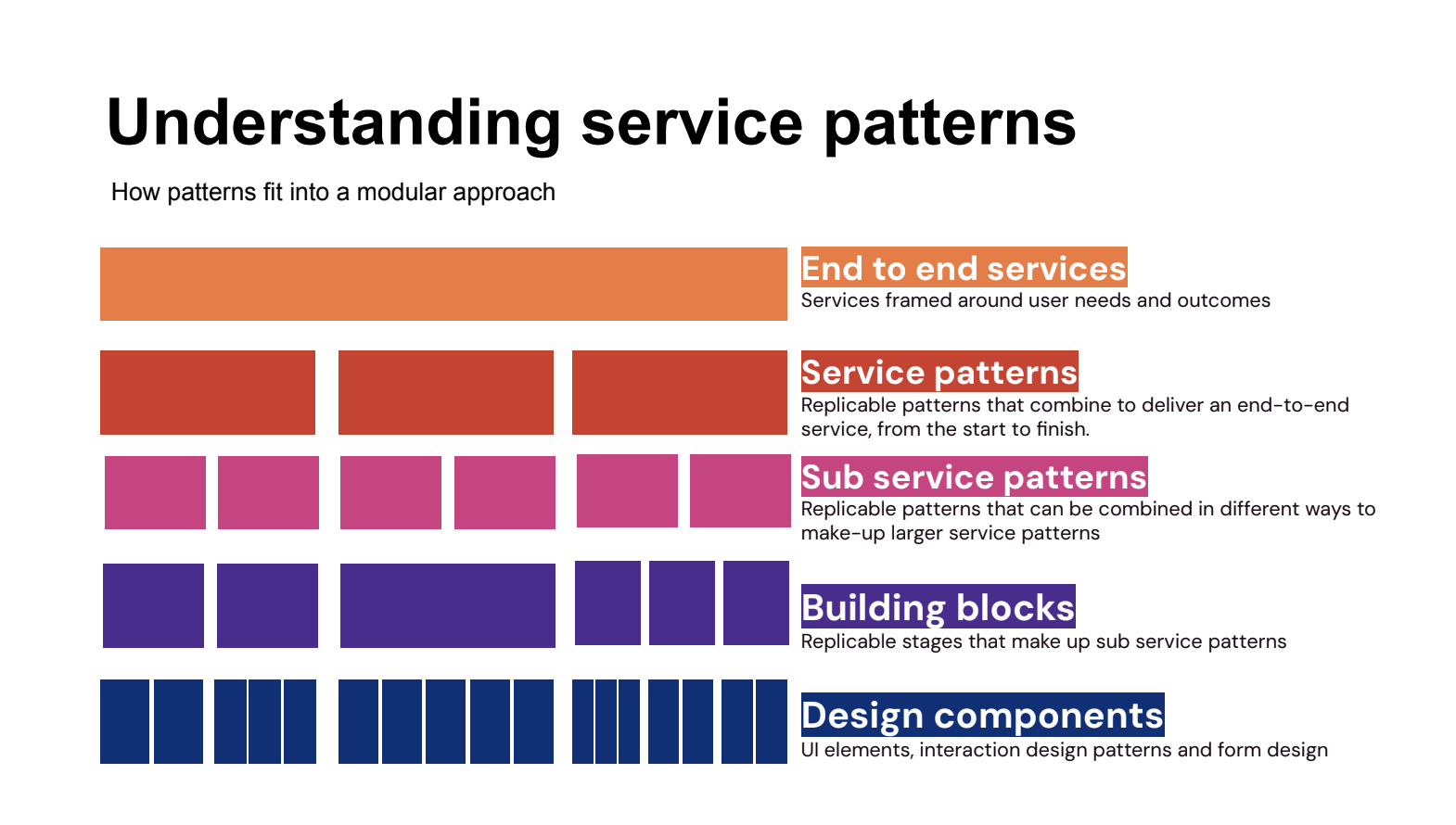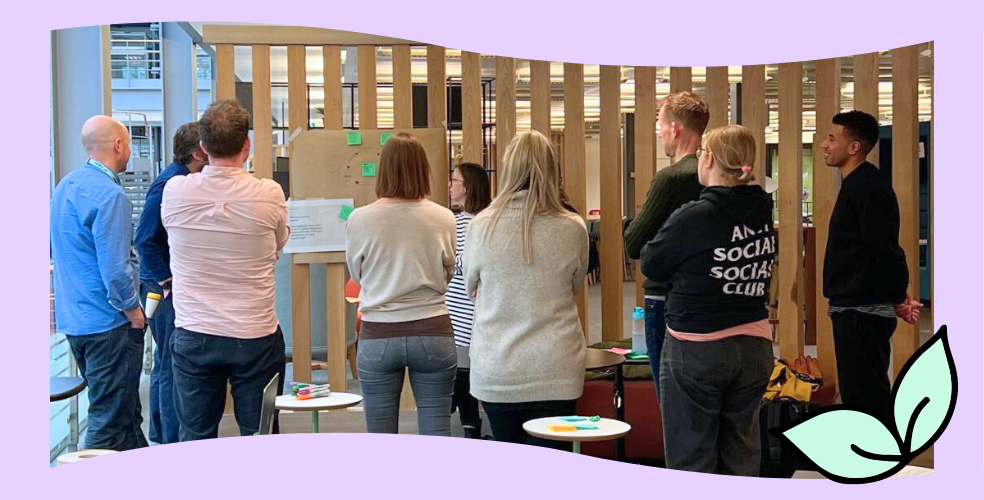We know patterns are key to scaling design. As part of design systems, they ensure a consistent and familiar user experience – making services quicker, easier and more accessible to use. Patterns also help teams to work more effectively, as they’re able to reuse existing work
The idea of ’service patterns’ is to create a replicable, modular approach to shape services from start to finish to meet user needs. This approach looks to identify and map reusable components that make up the building blocks of end to end services.
In this post we will share how service patterns can be used as a lever, not just to create reusable components, but to connect user needs to policy outcomes.
Building on our previous service pattern approaches
In 2019, some of our team worked with Essex County Council to map their services to identify common service patterns. The goal of this work was to explore service patterns and how they might help improve transactional services delivered by the council.
Since then, we’ve wanted to build on this approach, exploring how service patterns could be applied to non-transactional services and used for wider digital transformation in government.
Service design with the Department for Work and Pensions
More recently, we’ve worked with the User Centred Design team at the Department for Work and Pensions (DWP) on creating a service pattern approach that enables service transformation at scale.
Like many departments, DWP is rapidly modernising its services. To that end, they have a large design team and a design library with patterns and components. Language around patterns is familiar and these components, like those in many design systems, focus on reusable and common user interface (UI) components.
Working closely with Helen Spires (DWP’s Interim Head of Service Design), we started work here to understand whether service patterns could offer a strategic approach by mapping common components to common services and outcomes. Based on the Universal user needs and user pain points work from the User Research Practice and the service stages work from the Service Design Practice, we identified a set of common service patterns that could help design and develop services at scale, more cohesively.

The taxonomy we used to map service stages and components with DWP
A key difference between these patterns and the local government service patterns from our previous work in Essex, was the non-transactional nature and complexity of much larger end to end services that spread across multiple function teams. To manage this, we created a category of ‘sub-service’ patterns, which give designers more flexibility to use and reuse service patterns in different combinations across different services. In total, we identified nine service patterns, with 23 Sub-service patterns. Each sub-service pattern has attached building blocks (or around three to five steps). Together these show existing or new common patterns that make-up DWP services.

These draft patterns show existing or new common patterns that make-up DWP services from the users’ perspective
Since DWP is already in the midst of automating and modernising service, we think service patterns could fall under three categories:
- new – patterns based on future service visions
- in use – patterns that are needed to deliver existing services
- to be retired – interim patterns based on existing services, that might be retired to make way for future service based patterns and user journeys
Alongside these service patterns, we also identified a need to develop corresponding patterns for internal service users and staff, helping them respond and deliver services more efficiently and consistently.
Here, a service pattern approach is not just a way to create reusable components faster, but a user centred, tactical framework to strategically prioritise how to redesign and transform future services linked to how policy is being planned and implemented.
How service patterns create value for digital transformation
In summary, we think service patterns can be used strategically to design at scale by large teams who work across multiple services. This could be through:
- Using service patterns to prioritise and improve how existing services work:
Being able to see a matrix of patterns laid across multiple services and function areas helps highlight patterns that might be missing, are most repeated or need to be prioritised. This oversight helps give teams a clearer understanding of how services can be improved and how components can be replicated in different places. - Enabling a structured approach for designing future services:
Service patterns often need to start with understanding user needs and existing pain points for both internal and external users. In that respect, service patterns are always work-in-progress, which can help teams move from as-is to future states in a more structured, consistent and user-centred way.
Prototyping, testing and iterating common service patterns with services and their end users will ensure that patterns are evidence-led and can be confidently used at scale to deliver good outcomes and consistent experiences. - Going beyond accessibility and moving towards more inclusive services:
Design patterns are particularly useful in scaling accessibility through reusing components that follow accessibility standards. Service patterns can build on this further by bridging access to services with fairer outcomes through equitable patterns for services. For our work with DWP, our pattern templates included considerations for designing across different user contexts such as users holding different levels of trust, abilities and experiences (including offline and online interactions as part of a service). - Creating better consistently across different teams for policy implementation:
Service patterns can be used as an approach for not only organising design components, but shaping delivery across multiple teams. This approach has the potential to shift how services are designed and delivered, supporting teams to move from siloed working to working towards shared policy outcomes. This helps ensure that policies are consistently applied across different contexts and locations, reducing discrepancies in the way policies are implemented, changed and continuously improved upon for better outcomes. - Designing policies by focussing on end user needs and preferences:
Policies often look to address complex social systems challenges. While design alone cannot adequately solve these, it can provide an actionable and evidence-led way to experiment and test for new approaches. Service patterns can offer a starting point for policy considerations by focussing on the needs and preferences of end users. The approach also creates a structured framework for testing new approaches or policy experiments that can be rapidly deployed and improved upon.
Scaling and sustaining the use of service patterns
Overall, creating, curating and maintaining a set of reusable service patterns means:
- aligning and working across teams
- engaging multiple stakeholders
- following standard guidelines
- being evidence-led
- having a consistent language
There is a need to define governance and processes to support service pattern approaches alongside creating them. This includes considerations about updating patterns, identifying gaps and inconsistencies, and how patterns are retired in the future.
If you’re doing work around service patterns or are interested in learning more about this approach, do reach out to Megha for a chat.

User Centred Design as a service
Read moreOur recent design blog posts
Transformation is for everyone. We love sharing our thoughts, approaches, learning and research all gained from the work we do.

Lessons learned from joining projects in progress
We share tips for joining a project where there’s already an established design team in place.
Read more
Find out all about what our Design team has been up to over the past few months.
Read more
Em reflects on how we support large organisations to build confidence and embed approaches to support research activities.
Read more

